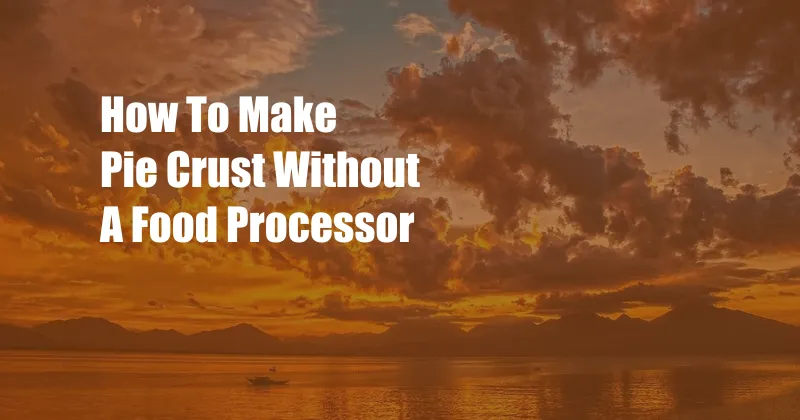
How to Make Pie Crust Without a Food Processor: A Culinary Journey
As an avid baker, I’ve always been known for my flaky, buttery pie crusts. But when my trusty food processor met an untimely demise, I was left wondering how I could recreate my culinary masterpieces.
Determined to overcome this culinary obstacle, I embarked on a journey of trial and error, experimenting with various techniques to achieve the perfect crust without the aid of a food processor. In this comprehensive guide, I’ll share my insights and techniques, empowering you to master the art of pie crust making by hand.
The Anatomy of a Flaky Crust
A flaky pie crust requires a delicate balance of flour, butter, and water. The key to success lies in the proper blending of these ingredients without overworking them. Overworking can toughen the gluten in the flour, resulting in a chewy crust.
To achieve flakiness, the butter should be incorporated into the flour in small, pea-sized pieces. These butter pockets will melt during baking, creating steam and separating the layers of dough, resulting in a tender and flaky crust.
Step-by-Step Guide to Pie Crust Perfection
- Measure and combine dry ingredients: In a large bowl, whisk together 2 1/2 cups all-purpose flour and 1 teaspoon salt.
- Cut in butter: Using a pastry cutter or two forks, cut in 1 cup cold, unsalted butter (cut into small cubes) into the flour mixture until the mixture resembles coarse crumbs.
- Add water: Gradually add 1/4 cup ice water, 1 tablespoon at a time, while mixing with a fork. Add only enough water to bind the dough together. Overmixing will toughen the crust.
- Form dough balls: Divide the dough in half, form into two balls, wrap in plastic wrap, and refrigerate for at least 30 minutes.
- Roll out dough: On a lightly floured surface, roll out one dough ball into a 12-inch circle. Transfer to a pie plate and trim edges.
Trending Techniques and Innovations
In the world of pie crust making, innovation is constantly evolving:
- Laminating dough: This technique involves rolling out the dough, spreading butter between the layers, and folding and rolling it several times. The result is a flaky, ultra-buttery crust.
- Using alternative fats: Bakers are experimenting with different fats besides butter, such as lard or shortening, to create crusts with varying textures and flavors.
Expert Tips for Success
- Use cold ingredients: Cold butter and water prevent the gluten in the flour from developing too quickly, leading to a more tender crust.
- Do not overwork the dough: Overworking the dough can result in a tough crust. Mix just until the ingredients are combined.
- Refrigerate the dough: Chilling the dough allows the gluten to relax and the butter to firm up, which makes it easier to roll out and prevents shrinking.
- Blind bake the crust: This involves baking the crust before filling it to prevent sogginess.
By following these expert tips and experimenting with different techniques, you’ll master the art of pie crust making and impress your friends and family with your culinary creations.
Frequently Asked Questions
- Q: Can I use a blender instead of a food processor?
A: Yes, you can use a blender to combine the dry ingredients and butter, but it’s important to pulse in short bursts to prevent overworking the dough. - Q: How can I fix a tough pie crust?
A: If your pie crust is tough, it may be due to overworking or using too much water. Try using a lighter hand when mixing and adding only enough water to bind the dough together. - Q: Can I make pie crust ahead of time?
A: Yes, you can make pie crust ahead of time and store it in the refrigerator for up to 3 days or in the freezer for up to 3 months.
Conclusion
Embarking on the journey of making pie crust without a food processor can be an enriching experience, inviting you to delve into the nuances of pastry making.
Whether you are a seasoned baker or a curious novice, this guide has equipped you with the knowledge and techniques to create flaky, buttery pie crusts that will elevate your culinary repertoire. By embracing the techniques, tips, and insights shared here, you can unlock the secrets of pie crust mastery and delight your taste buds with homemade masterpieces.
Are you ready to embark on your own pie crust-making adventure? Share your creations and queries in the comments below, let’s engage in a pie-filled conversation!